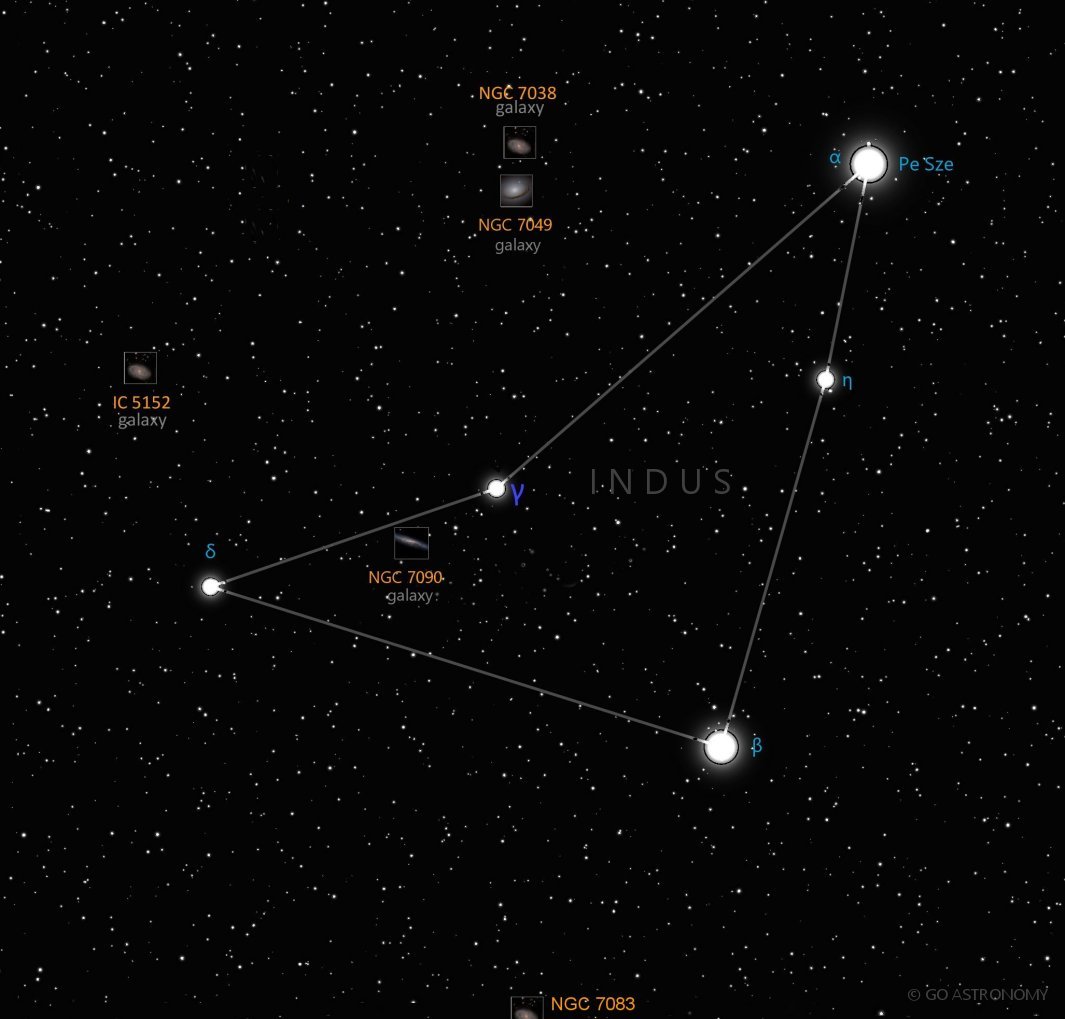Indus, the Indian (Ind)
(IN-dus)
The Southern constellation of Indus, the Indian, is best viewed in Fall during the month of September.
Indus is the 49th largest constellation. It's brightest star is Persian at magnitude 3.11. The boundary of the Indus constellation contains 6 stars that host known exoplanets.
- Pronunciation:
- IN-dus
- Meaning:
- Indian
- Genitive:
- Indi
- Abbreviation:
- Ind
- Constellation Family:
- Bayer
- Hemisphere:
- Southern
- Quadrant:
- SQ4
- Visibility:
- 15° N - 90° S
- Best viewing month*:
- September
- Area:
- 294 sq. degrees
- Size:
- 49th largest
- Right Ascension (avg):
- 21h 8m
- Declination (avg):
- -58°
- Brightest star:
- Persian (3.11)
- Stars with planets:
- 6
- Messier objects:
- |
- Caldwell objects:
- |
Brightest Stars in Indus
The 10 brightest stars in the constellation Indus by magnitude.
- Star
- Magnitude
- Spectral class
- Alpha Indi (α Ind)
- 3.11
- K0III
- Beta Indi (β Ind)
- 3.67
- K0III
- Theta Indi (θ Ind)
- 4.39
- A5V
- Delta Indi (δ Ind)
- 4.4
- F0IV
- Eta Indi (η Ind)
- 4.51
- A6 var
- Epsilon Indi (ε Ind)
- 4.69
- K5V
- Zeta Indi (ζ Ind)
- 4.9
- K5III
- Iota Indi (ι Ind)
- 5.06
- K1II/III
- Mu Indi (μ Ind)
- 5.17
- K2III
- Nu Indi (ν Ind)
- 5.28
- A3V + F9V
Galaxies in Indus
The most notable galaxies in the constellation Indus. Also see all galaxies.
Milky Way Satellites in Indus
Dwarf satellite galaxies that orbit the Milky Way Galaxy located in the constellation Indus. Also see all Milky Way satellite galaxies.
- Galaxy name
- Alt name
- Magnitude
- Indus II
- Kim 2/Indus I
The Indian Constellation
Indus is a small and faint constellation in the southern sky. It represents an Indian, a term originally used by early European explorers to describe the indigenous people they encountered in the New World. However, the constellation has no particular historical or mythological significance attached to any specific culture.
Historical Overview
The constellation of Indus was originally created in the late 16th century by Petrus Plancius, a Dutch astronomer, and it first appeared in a celestial atlas by Johann Bayer in 1603. It's one of the 12 constellations introduced by Dutch navigators Pieter Dirkszoon Keyser and Frederick de Houtman. The constellation was later adopted by the International Astronomical Union (IAU) as one of the 88 modern constellations.
Location and Main Features
Indus is located in the fourth quadrant of the southern hemisphere (SQ4) and can be seen at latitudes between +15? and -90?. Covering an area of 294 square degrees, it ranks 49th in size among the 88 constellations. It is bordered by the constellations of Grus, Microscopium, Octans, Pavo, Sagittarius, Telescopium, and Tucana.
Major Stars
Although Indus is small and lacks bright stars, it contains several stars worthy of mention. The brightest star in the constellation, Alpha Indi, also known as "The Persian," is an orange giant of spectral type K0IIIb located approximately 101 light-years away, with an apparent magnitude of 3.11. It's an evolved star that has used up its core hydrogen and has expanded to 12 times the sun's diameter.
The second-brightest star, Beta Indi, is a yellow-white giant star situated about 600 light-years from our solar system. It's nearly 60 times more luminous than the sun.
Theta Indi is a binary star system composed of a white main-sequence star of spectral type A5V and a yellow-white main-sequence star of spectral type F7V. This binary system is located about 90 light-years away from Earth.
Deep Sky Objects
Indus doesn?t have any Messier objects and there are no meteor showers associated with the constellation. However, it does house several galaxies. NGC 7049 is a notable example, being a lenticular galaxy with a dust disk and a large halo of globular clusters. Another interesting deep-sky object within the boundaries of the constellation is NGC 7083, a spiral galaxy located approximately 142 million light-years away.
Observation
Indus is best observed during the month of September. From most northern latitudes, the constellation is largely invisible, although its northern portions can be viewed from southernmost parts of Florida or Texas. The entirety of Indus is visible at latitudes south of 33 degrees north from July through September.
Indus in Modern Astronomy
Despite its faintness and lack of bright stars, the constellation of Indus holds a unique place in the sky. It's home to the Indus Galaxy Cluster (Abell 3656), a large cluster of galaxies in the southern celestial hemisphere. Furthermore, the research on variable stars and binary systems, as well as deep-sky objects like galaxies in Indus, continues to contribute to the overall understanding of the universe.
* Constellation shown for northen hemisphere skies. For the southern hemisphere, constellations appear rotated 180 degrees (upside-down and left-right reversed) from what is shown. Remember that seasons are reversed too - summer in northern latitudes is winter in southern latitudes.
** Circumpolar constellations are visible year-round in the hemisphere listed (and not at all in the opposite hemisphere).





